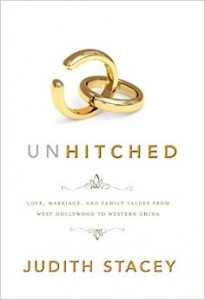 Unhitched: Love, Marriage, and Family Values
Unhitched: Love, Marriage, and Family Values
from West Hollywood to Western China
by Judith Stacey
New York University Press. 275 pages, $27.95
IT WASN’T long ago that the generally held definition of a “family” was simple: a unit comprised of mom, dad, and the kids. And the popular image wasn’t far off: in the 1950’s, four out of five households consisted of a married couple of the opposite sex, with children typically present. But today’s homes are filled with millions of unmarried adults with or without a significant other and mostly without children. The divorce rate is a contributing factor, as is the willingness of couples to cohabitate without marriage. Conversely, more and more same-sex couples are forming domestic partnerships or, where it’s legal, getting married, and many are adopting children or having their own.
Outside the U.S., things are no less complicated, but often in different ways. In South Africa, for example, heterosexual monogamous marriage is still the norm for whites, while a re-awakened pattern of polygyny is widely accepted in the native African community, with men of sufficient means marrying second or even third wives.
Author Judith Stacey, professor of sociology at NYU, has studied families extensively for decades. This book is a wrap-up of her previous studies, and she uses it to debunk received wisdom about marriage and the family. For example, she shows handily that marriage is neither necessary nor universal, that a married man and woman are not essential for a “family” to exist in many cultures, and that children do not need a parent of both sexes to grow up emotionally stable. She also documents the extent to which family structures that were once deemed unacceptable have moved from the tolerated to the commonplace. While that may be nothing new to readers living the lives she describes, it’s oddly comforting to see the statistics in print.
Stacey is nothing if not thorough, looking at marriage and family from a range of perspectives in a large number of foreign cultures and American subcultures. Seasoned students of American society will undoubtedly find something new here, and those who enjoy learning about life in other cultures will soak up her examinations of South African and Chinese family units. Even the author herself admits to being surprised by some of her findings.
Stacey’s enthusiasm for her subject is infectious, though at times the general reader may find the material to be somewhat dry and academic. There are times when the book shifts without warning from spirited narrative to stone-faced lecture. Fortunately, the drought doesn’t usually last too long, and Unhitched returns to being a people-watcher’s delight, an armchair sociologist’s fantasy, and great ammunition for anyone who wants to win an argument against the permanence or necessity of the “traditional” family.
________________________________________________________
Terri Schlichenmeyer is a freelance writer based in Wisconsin.





